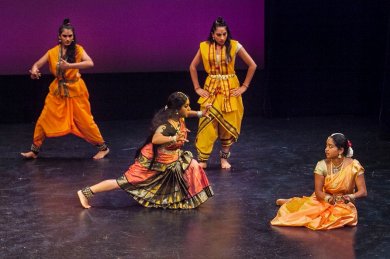
|   |

|   |
Ramya Ramnarayan in "Heritage Heroines" - Robert Johnson Photos: David Glasofer October 12, 2015 (This article originally appeared in NJArts.net, and is reprinted with permission.) The Sanskrit epics are replete with intriguing characters, many of them women. This literature is a gold mine for performers like Ramya Ramnarayan, an Indian dancer based in North Brunswick, who can return again and again to the ancient stories for inspiration. Ramnarayan adopted various guises at the Crossroads Theater in New Brunswick in a program titled ‘Heritage Heroines,’ which also featured students from her Nrithyanjali Institute and an appearance by guest artist and fellow dancer Shila Mehta. While Ramnarayan’s own performance remained the focus- especially a solo in which she impersonated Mandodari, the grieving widow of the 10-headed demon king Ravana - the students’ participation also gave her a chance to show her skill in arranging groups. And while this program with a mix of live and recorded music was heavily weighted in favor of narrative, Mehta’s involvement supplied the pretext for a fascinating duet or jugalbandi, highlighting the contrast between different branches of Indian classical dance. While Ramnarayan is an exponent of Bharatanatyam from Tamil Nadu, Mehta practices Kathak, a style developed in the Mughal courts of Northern India. Ramnarayan made her first appearance as Kaikeyi, a queen whose attempt to make her son heir to the throne of Ayodhya has disastrous consequences in the epic Ramayana. Kaikeyi isn’t the only one worried about the royal succession. Her maidservant, Manthara, fancies the outcome will affect her own position at court; and Manthara’s scheming provides a wonderful foil. Displaying Kaikeyi’s reactions to her servant’s grumbling, Ramnarayan appears amused and indulgent at first, but then her expression darkens, poisoned with misgivings. Student dancer Amrutha Sridhar was Manthara, in a performance salted with irony. Sometimes the characters, who rouse our warmest affection are not the most admirable. This includes the unfortunate Surpanaka, the demoness who, in another Ramayana excerpt, develops a two-pronged crush on Lord Rama and his handsome brother, Lakshmana. Though passionate, Surpanaka is no great beauty. The choicest moment of this vignette comes when student Deepa Vanamalli, as the demoness, spies her reflection in a pool and realizes that before her planned seduction of Rama and Lakshmana can succeed, she needs a make-over.  Ramya Ramnarayan’s group  Shila Mehta and Ramya Ramnarayan Lovely Rukmini, on the other hand, is fortunate in her charms. All she requires is devotion, and a messenger to take her prayers to Krishna and the amorous god will appear to carry her off in his chariot. Student dancer Neha Narayanan played Rukmini, bringing a wealth of expressivity to this young heroine’s dreams, while Ramnarayan’s arrangement of the well-drilled student ensemble added the beauty of geometry and fanciful tableaux to the episode. Behind every 10-headed demon, perhaps, there is a woman. In Ravana’s case, she was Mandodari, whose sage advice the king of Lanka ignored at his own peril. Even after his death, Mandodari won’t stop nagging- if only he had listened! - although when she finds her husband lying on the field of battle her pleas take the form of a reproach. Here, Ramnarayan uses her dancers to set the scene, first showing us the battle, so that when, as Mandodari, she comes upon Ravana’s toppled crown we understand where we are and can feel her desolation without additional props. Ramnarayan avoids histrionics, and while her performance depends upon alternating impressions of Mandodari’s admiration for her late husband and disbelief at his defeat, one of the most effective moments is the lingering pause she takes, recoiling from her discovery and allowing the dreadful truth to sink in. Shila Mehta, the Kathak dancer, has a story of her own to tell. Whirling as she switches characters, she portrays the unhappy warrior Arjuna, shrinking in dismay from the prospect of killing his own family members, and then she gives us Krishna, smiling benevolently as he hands Arjuna his bow and arrow, giving him the confidence to fulfill his destiny. The friendly jugalbandi brings both styles into relief. While the Kathak dancer moves smoothly, wrists curling and legs straight as she stamps out rhythms and casts beguiling glances over her shoulder, the Bharatanatyam dancer (Ramnarayan) is all bends and angles, leaping and carving the space around her body with forceful gestures. The speed and virtuosity of the movement is captivating. |